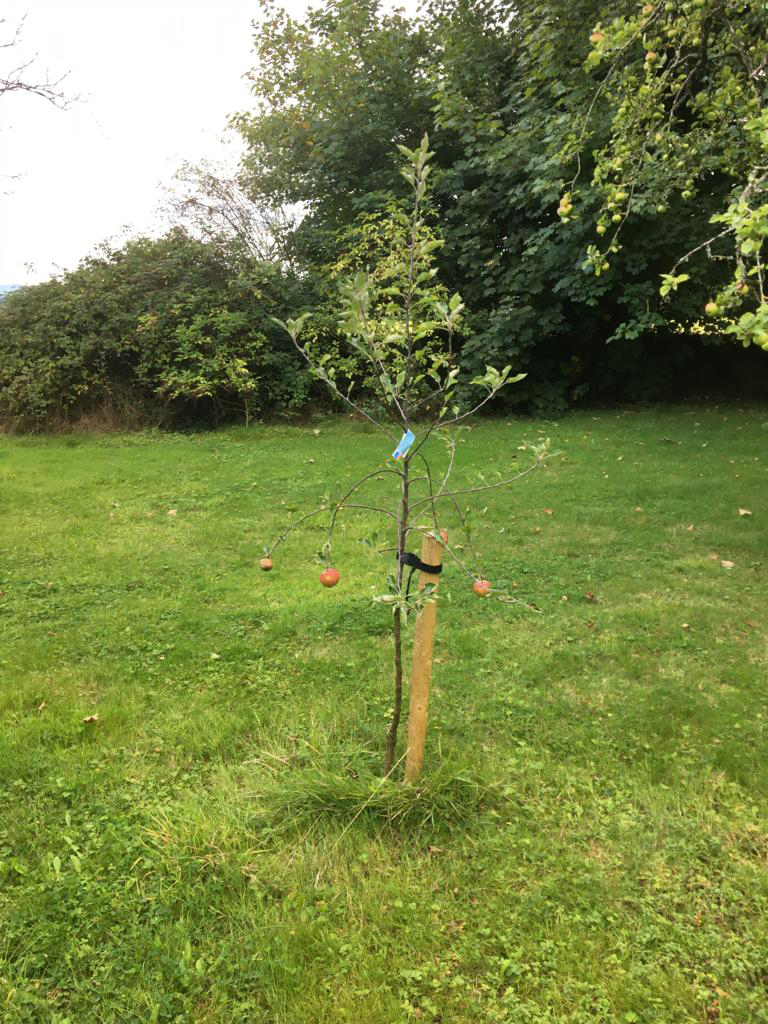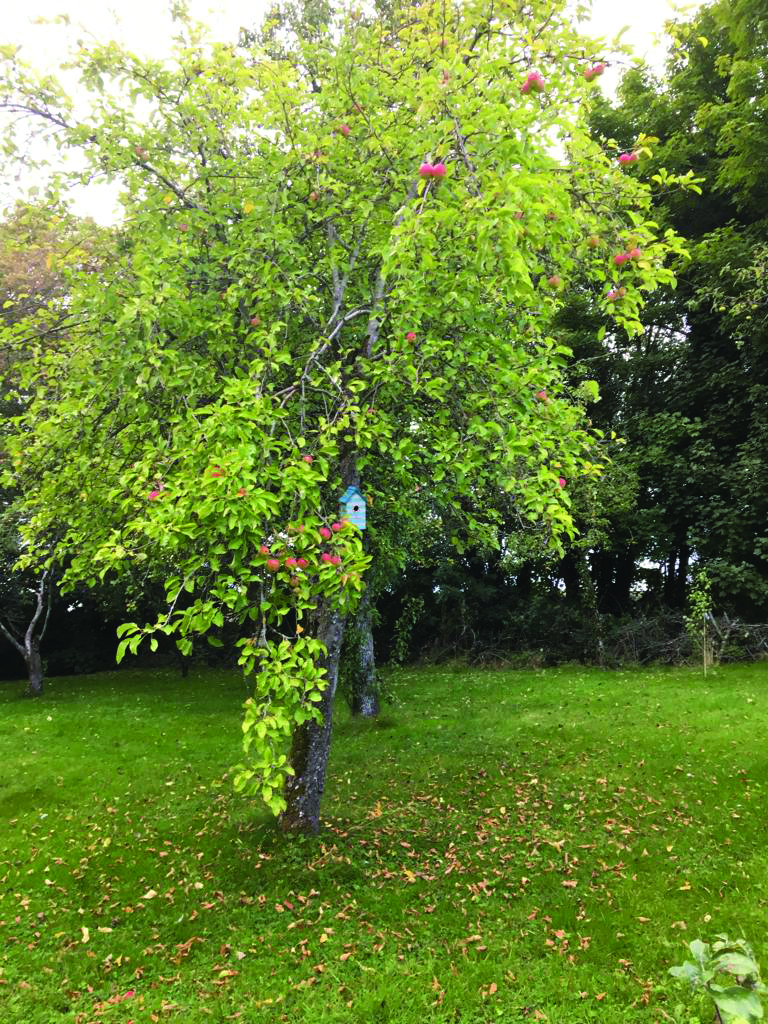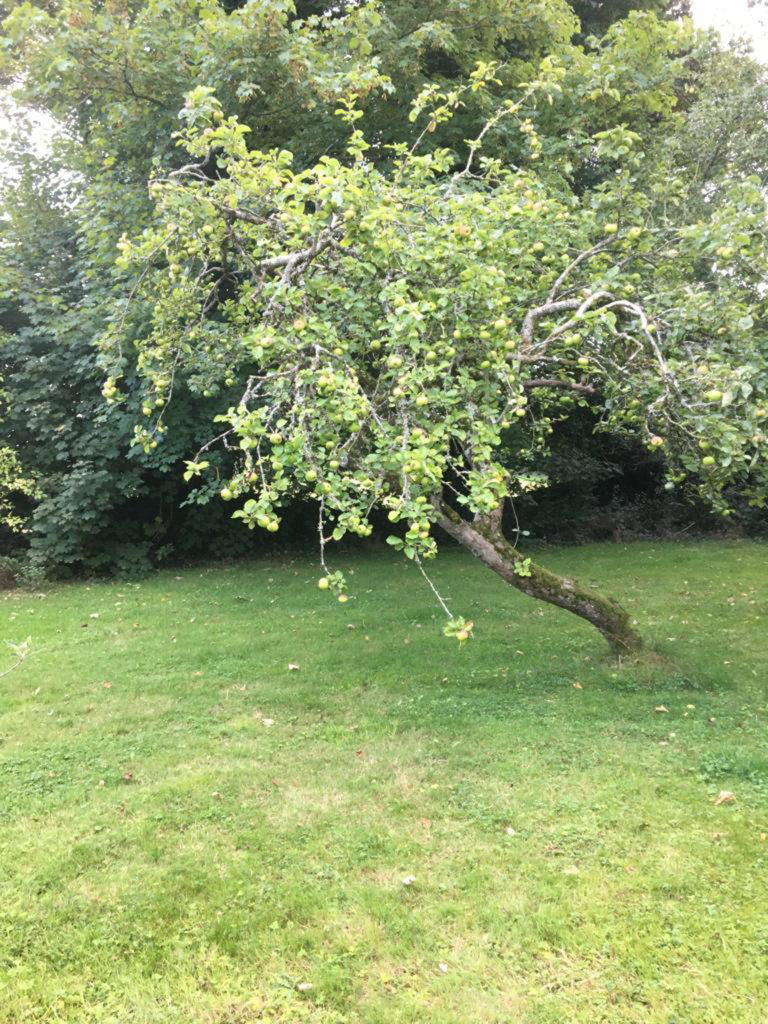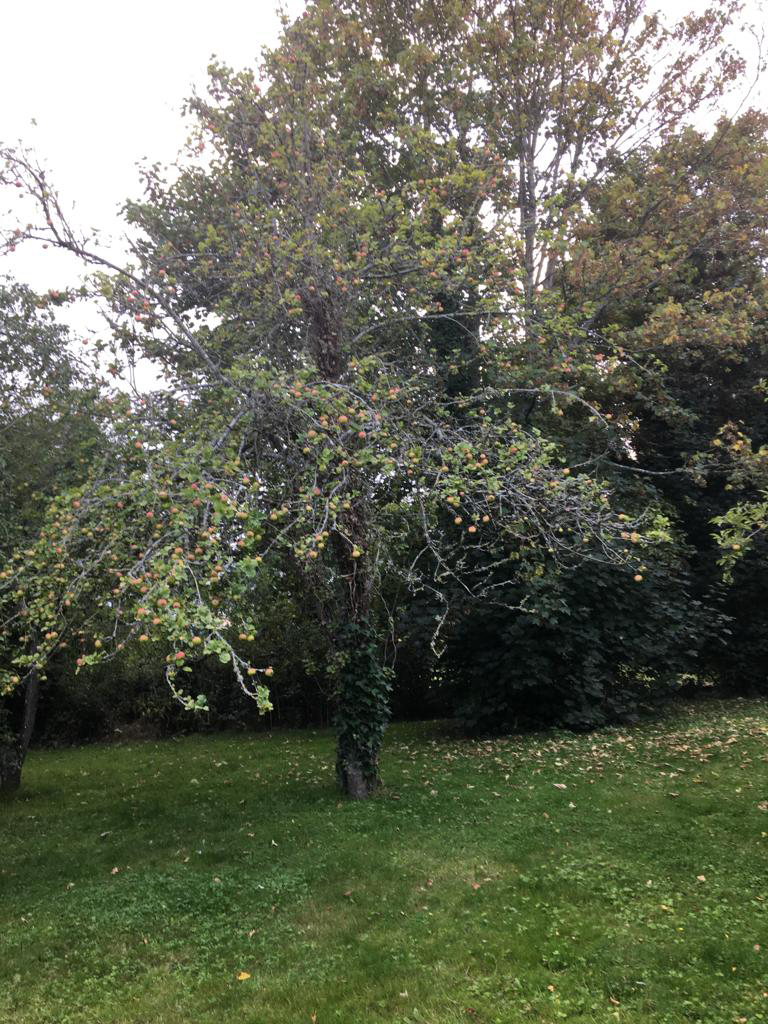Apples are abundant in Ireland in the fall, and they play a key role not only on the table but in festivities as well.
Several years ago after a rigorous day of exploring County Laois, I pulled into a pub for a well-deserved pick-me-up pint. It was a wee bit early for the local drinking crowd and the long bar held only one customer, a young man who looked more like a fellow whose regular haunt would be a Dublin watering hole rather than a remote country pub. His tweed jacket hugged the shoulders of his barstool, his tie was loosened, his collar was unbuttoned, and he was gulping a very large glass of some clear golden fizzy liquid. No doubt about it, this fellow was unwinding after a hard day.
I sat nearby and we began to chat. He was a traveling salesman for a computer company, and every week he spent three grueling days servicing his route from Dublin to Galway. This was his favorite stop midway. He ordered another round. Curiosity compelled me to ask what he was drinking, Bulmer’s apple cider. The night before he’d been so thirsty he’d had 13 glasses. “Oh, how refreshing,” I said. He ordered me a round. Thinking the beverage was just like the stuff sold back home in the fall, I took a great big swallow. No. It was apple alcohol.

So began my introduction to the world of hard cider, that divinely sweet intoxicating apple nectar the Celts were brewing long before Caesar’s survey team named Ireland Hibernia (the place for sleeping). It’s a good guess those sturdy legionnaires spent a night sipping cider with the locals. One glass and I was ready for nap time. How my drinking partner made a habit of putting away more than a dozen giant glasses of the stuff and was still able to function is a thought that still amazes me.
Like potatoes, apples are abundant in Ireland in the fall, and they find their way onto the table in a myriad of ways. Irish apple pie and crumble are legendary, and the Michaelmas roast goose traditionally has an apple stuffing. On the first night of the ancient Samhain harvest celebration (Halloween), apples played a key role not only on the table but in the festivities as well. While merrymakers munched on steaming apple turnovers and quenched their thirst with mugs of hot spiced cider, revelers bobbed for apples floating in buckets of water or tried to take bites out of apples hung from strings. Before each attempt, the bobber or biter said aloud a letter of the alphabet. If the catch was successful, the letter spoken would begin with the first name of the player’s future spouse.
Apples are found in the folk tales of many people. Norse legends lauded the apple as the fruit the gods ate to maintain their youth and beauty as they aged. Beauty and apples figure in Greek myth as well. When three goddesses each claimed a golden apple reserved for only the most beautiful, Zeus begged out of the dicey decision and passed the buck to a mortal named Paris. Paris awarded the apple to Aphrodite, who in turn rewarded Paris with the love of Helen, Earth’s fairest maiden. Unfortunately, Helen was already married to another man, and when the star-crossed lovers ran off together, their elopement lit the fuse of the infamous Trojan War.
Though there is no proof to this belief, the apple is commonly depicted as the fruit of temptation in the Garden of Eden. A related myth tells that when Adam bit from Eve’s “love apple” a piece of the fruit stuck in his throat creating the physiological feature known as the Adam’s Apple and forever marking humans (especially men) as susceptible to sexual seduction.
Ireland has its own apple miracle tale. Supposedly, sometime shortly before Jesus’ birth, the Virgin Mary craved an apple. When Joseph refused to climb and pick it for her, the tree bent down to bring its fruit within reach of Mary’s hand, and ever since the apple tree has had low drooping branches. Another tale tells how on the fabled island of Tir na nOg, eating apples allowed the fairy folk to remain forever young and beautiful.
At the Mesolithic site of Mount Sandel, County Derry, there is archaeological evidence that apples have been cultivated in Ireland for 9,000 years. In pre-Roman times, the Druids revered the apple’s star-shaped seed distribution that forms the sacred pentacle symbol, and the tree’s abundant yield earned its fruit a reputation as a fertility charm. During the early historic period, most of the large monasteries planted large apple orchards. A notation in the 9th-century records of the Culdee monks reads: “In case of apples if they be large, five or six with bread will suffice for a meal, but if small, twelve apples are allowed.”

The Brehon Laws, which were written in 438 A.D. during the tenth year of King Leary’s reign, extended legal protection to all apple trees by establishing that any tenant must be compensated for “any that his own hand had planted.” The apple tree was so treasured that it was one of three things (the others being a hazel bush and an oak grove) that could only be paid for with other living objects such as cattle, dogs, or horses.
Thanks to air transport, apples are available year-round, but when fall ushers in the harvest, apples are plentiful and inexpensive. A bonus of the American season is the opportunity to purchase raw unfiltered apple juice. Talk about Nectar of the Gods! The shelf life of fresh squeezed juice is much shorter than the bottled stuff available commercially. Drink it soon after purchasing or it will begin to ferment.
Apple cider is really fermented apple juice. Slight fermentation produces a lightly effervescent cider that’s heavenly when warmed with slices of oranges, cloves, and cinnamon. Heavier fermentation tums the fruit sugars into alcohol. Americans call this “hard cider,” and the longer it ferments, the bigger its alcoholic punch.
If left exposed to the air, apple cider will turn to vinegar rather than an alcoholic brew. One can actually do this at home by placing cider in a glass jar covered with cheesecloth and letting it sit in a cool corner of the kitchen. In a few weeks, Micoderma aceti bacteria will transform your cider into a delicious fruity vinegar that can then be bottled as is or made even more exotic by adding a few sprigs of herbs or berries to the container.
Don’t be alarmed if an icky-looking gray scum forms across the top of your cider vinegar while it’s aging. This bacterial formation is called “the vinegar mother” and it’s vital to the vinegar-making process. For appearances’ sake, skim it away before rebottling your finished vinegar, but don’t throw it away! Place the “mother” in a separate jar with a bit of the vinegar it has created and keep it in a dark cool cupboard. When you’re ready to make another batch, adding the “mother” will speed up the process.
Aside from being great to eat raw, infinitely variable cooked, a delicious beverage, selectively intoxicating, and the source of exquisite vinegar, apples are jam-packed with vitamins A and C, trace minerals, healthy soluble fiber, and pectin (the key jelling ingredient in jams and preserves).
With their treasure trove of uses and benefits, apples have no equal in the fruit world. They have even entered the language as similes of perfection. There’s no higher compliment than calling someone “the apple of my eye,” and “apple pie and Mom” stands for the honor to our country. The Irish talk about a time being right by saying. “When the apple is ripe, it will fall.” The next time you bite into one of these succulent treats, remember another old maxim: “An apple a day keeps the doctor away.” It’s probably the reason apples were such favorites of the fairy folk on Tir na nOg.
Slainte!



Older trees in this Irish orchard are still bearing fruit, and a new sapling is already fruitful. Photos by Kate Harty
Recipes
Friar’s Omelette
1 pound apples, peeled, cored, sliced
4 ounces brown sugar
1 clove
pinch of mace
juice of 1 lemon
2 eggs, well beaten
4 ounces breadcrumbs
3 tablespoons butter
Cook the apples with 2-3 tablespoons of water, most of the brown sugar, the clove, and mace, stirring occasionally until they form a puree. Beat in the lemon juice and 2 tablespoons butter, and cool. When quite cold, add the beaten eggs and mix in. Grease an overproof dish with the rest of the butter and coat thickly with breadcrumbs on the sides and bottom. Put the apple mixture in and cover the top thickly with the rest of the crumbs. Bake in a preheated oven at 350F degrees for approximately 30 minutes. Serve hot or cold sprinkled with the rest of the brown sugar. Garnish with whipped cream if desired. Makes 4 servings.
– Irish Traditional Food, Theodora Fitzgibbons
Caramelized Apple Flan
Caramelized Apple Flan
Shortcrust Pastry:
4 oz flour
1 oz butter or margarine at
room temperature
1 oz lard at room temperature
pinch of salt
cold water, to mix
Filling:
4 oz dark brown sugar (110g)
1 tablespoon powdered cinnamon
2 lbs, peeled, cored, and thinly sliced (Golden Delicious)
Pastry: Sift the flour and salt into a large bowl, holding the sieve up as high as possible to give the flour an airing. Cut the lard and butter into small cubes and add them to the flour. Using your fingertips, lightly rub the pieces into the flour – lifting up your hands up as high as you do this – to incorporate air and being as quick as possible.
When the mixture looks uniformly crumbly, start to sprinkle roughly 2 tablespoons of water all over. Use a round-bladed knife to start the mixing, cutting and bringing the mixture together. Carefully add more water as needed, a little at a time, then finally bring the mixture together with your hands to form a smooth ball of dough that will leave the bowl clean. (If there are bits that won’t adhere to the dough, you need a spot more water.) Rest the pastry, wrapped in foil or polythene in the refrigerator for 20-30 minutes before rolling out.
Preheat the oven to 350 degrees. Prepare an 8-inch (20cm) cake tin, by brushing with melted butter. Cover the base with a circle of greaseproof paper and brush again with melted butter.
Cover the base of the tin with brown sugar, pressing it down evenly. Sprinkle on the cinnamon and then arrange the sliced apples neatly. Roll out the pastry to a thickness of approximately half an inch (1cm) and cut out a circle that will fill the top of the tin. Cover the apples with the pastry, pressing it down gently.
Place in the center of the oven for 40 minutes until the pastry is golden. When the flan is cold, loosen it around the edges, cover with a plate and carefully turn it upside down, then remove the tin and greaseproof paper. Serve with whipped cream or crème fraiche.
– Recipe and photo from Delia Smith’s Complete Illustrated Cookery Course
Darina Allen’s Cullohill Apple Pie
INGREDIENTS
1 cup (1 brick) Kerrygold Salted Butter / 1/4 cup sugar, plus 2/3 cup for the filling and a little extra for sprinkling / 2 large eggs, plus an extra for egg wash / 2 1/2 cups all-purpose flour / 11/2 pounds (4 to 5) tart crisp apples, such as Granny Smith, peeled, quartered, cored, and sliced1/8 teaspoon ground cloves (optional)
Cream butter and 1/4 cup of the sugar in the bowl of an electric mixer; add 2 of the eggs and beat until smooth. Reduce mixer speed and add flour a heaping half cup at a time to form stiff but sticky dough. Turn onto a floured surface and form into a ball. Divide dough into 2/3 and 1/3 portions; wrap each in plastic and press to flatten into a round. Refrigerate at least 1 hour and up to 3 days. When ready to bake, adjust oven rack to lower-middle position and heat oven to 350 degrees. Toss apples with remaining 2/3 cup of sugar and the cloves. Roll the larger dough round on a floured surface to a 13-inch circle; fit into a 10-inch tart pan or a 9 1/2-inch deep-dish pie plate. Turn apples into pie plate. Roll remaining portion of dough on a floured surface into a 10-inch circle. Lay pastry over apples and pinch with bottom piece of dough to seal; flute edges. Brush with an egg wash, and decoratively slit the dough top with a paring knife. Bake until pie is golden brown, 45 to 60 minutes. Remove to a wire rack to cool. Cut into slices and serve.
For more about the Ballymaloe Cookery School, visit www.cookingisfun.ie.


Leave a Reply